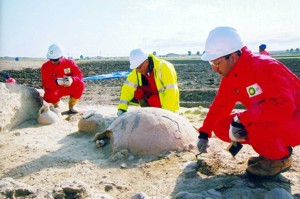The BTC Pipeline Archaeological Excavations in Azerbaijan
David Maynard, 2011. https://doi.org/10.5284/1000411. How to cite using this DOI
Data copyright © David Maynard unless otherwise stated
This work is licensed under the ADS Terms of Use and Access.
Primary contact
David
Maynard
Managing Director
Landsker Archaeology Ltd.
Llys Aeron
Hebron
Whitland
Carmarthenshire
SA34 0XX
UK
Resource identifiers
- ADS Collection: 1057
- DOI:https://doi.org/10.5284/1000411
- How to cite using this DOI
Introduction

The Baku-Tbilisi-Ceyhan and South Caucasus Pipelines (BTC) were constructed through Azerbaijan, Georgia and Turkey during the period 2003-5. The construction of the pipelines was accompanied by a five phase archaeological project intended to investigate and mitigate the effects of this construction. The project grew from small beginnings in 2001 to include a continuously operating team of around 80 staff during 2005 that included members of the Institute of Archaeology and Ethnography (IoAE) in Baku together with international archaeologists and local labourers. This project was the largest archaeological enterprise in Azerbaijan for many years prior to the end of the USSR.
Archaeological results from the project included over 40 excavations on sites of varying date together with surveys of different pipeline route options and the study of numerous sites while crossing the country. The project coincided with the introduction of GPS measuring equipment and the use of satellite imagery and mapping, some of which was prepared specifically for the project. This meant that for the first time local archaeologists could record geographical information to a level that had previously been unavailable. Novel techniques were introduced such as aerial archaeology, digital images and the collection of over 50 radiocarbon dates.
The archaeological sites themselves covered a range of periods and types from Chalcolithic and Bronze Age settlements and cemeteries and Antique cemeteries. Medieval sites were represented by a potential Christian chapel and associated cemetery together with a number of rural settlements of varying complexity. A key result of this project was the appearance of Chalcolithic sites that dramatically extended the limited corpus of known sites in Azerbaijan. This included the almost invisible evidence for the Kura Araz culture and the excavation of rural medieval sites that would previously have been ignored in favour of more interesting and finds-rich urban sites.
Palaeoenvironmental evidence was represented by the discovery of woolly mammoth teeth, charred plant remains from medieval sites and human bone analysis. Again these are techniques not commonly utilised in previous studies.
The project attempted to reach international standards, and interesting distinctions were noted between Azeri and western archaeologists. The overriding Azeri interest was in the collection of material for later desk study, while western archaeologists were keen on elements such as landscape study and more recent cultural heritage such as decorated bus stops, generally disregarded by their Azeri colleagues.
Phasing of Work
The work proceeded in accordance with the following 5 phases that have gained broad acceptance from national and international agencies.
- Phase 1 - Areas of potential archaeological interest were identified by various desk based activities such as documentary searches for previous archaeological work and examination of aerial and satellite images. The route of the pipeline was examined on the ground to assist in the determination of potential impact.
- Phase 2 - Areas of archaeological potential lying within the construction corridor (50m) were examined to determine their nature and significance. Sixteen locations were examined in this phase through detailed survey and trial trenching.
- Phase 3 - In areas where damage to the resource was unavoidable, archaeological deposits were recorded by excavation prior to construction activities. Four sites were examined as part of this phase.
- Phase 4 -The construction process revealed many previously unknown archaeological features and over 36 sites were located and subjected to excavation.
- Phase 5 - The study of material and preparation of reports on the archaeological works carried out during the project. This phase includes the dissemination of the results of the work both to the archaeological establishment and to the wider public via an appropriate medium.
Co-authors for particular aspects of the article have been Najaf Museyibli (who led the Azerbaijani excavations on behalf of the Institute of Archaeology and Ethnography, Baku, Azerbaijan), and Paul Michael Taylor (for components having to do with the Smithsonian's recent activities in the field of museum capacity building for the improved physical storage of, and data storage about, the excavated materials and the excavation records.
The following have written parts of the article or reports within the archive:- Christopher Polglase (URS), Richard Moore (Network Archaeology), Paul Michael Taylor (Smithsonian Institution), Najaf Museyibli, Muzaffar Huseynov Safar Ashurov, Bakhtiyar Jalilov, Mikayil Mustafayev, Farhad Guliyev, Gahraman Agayev Victor Kvachidze, Arif Mammadov, Tarikh Dostiyev and Fuad Huseynov (Institute of Archaeology and Ethnography, Baku), and others.
This digital archive was undertaken in conjunction with an electronic publication through the Linking Electronic Archives and Publications II (LEAP II) project, funded by the Andrew W. Mellon Foundation. The corresponding article is 'Archaeological Excavations on the BTC Pipeline, Azerbaijan' by Paul Michael Taylor and David Maynard', which can be found in Internet Archaeology 29.




